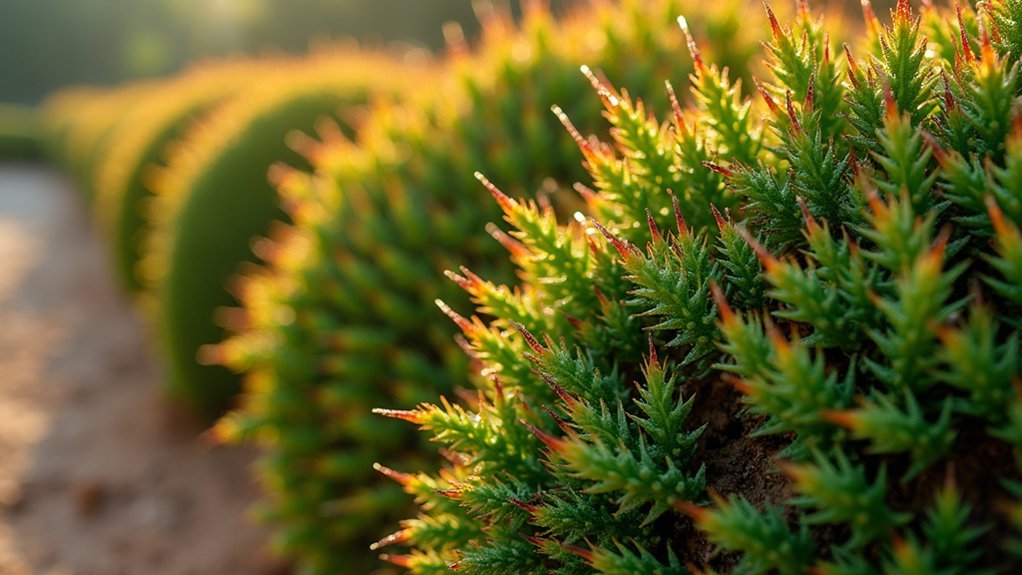Several thorny, drought-resistant hedges provide excellent home protection while conserving water. Consider Osage Orange for its impenetrable barrier and minimal maintenance, Pyracantha (Firethorn) for vibrant berries that attract birds, or Hawthorns for striking flowers and wildlife support. Barberry thrives in shade and drought conditions, while Elaeagnus offers fire resistance and privacy. Plant these options close together (200-300 per 100 yards) for maximum effectiveness. Discover how these living barriers can enhance your property’s security and ecological value.
Top Thorny Hedge Options for Water-Scarce Landscapes

When drought conditions threaten your landscaping plans, thorny hedges offer a perfect solution that combines security with water efficiency. Osage Orange stands out with its bug-repelling fruit and formidable thorny barrier, requiring minimal maintenance in dry regions.
Thorny plants create nature’s own security system while thriving in water-scarce environments.
For visual appeal with functionality, consider Hawthorns with their striking flowers and bright red berries that thrive in heat while supporting local wildlife. The African Acacia species are particularly effective at creating impenetrable barriers, as evidenced by their use to deter lions in their native habitats.
For visual appeal with functionality, consider Hawthorns with their striking flowers and bright red berries that thrive in heat while supporting local wildlife.
Elaeagnus Silverberry provides a dense, fire-resistant privacy screen that adapts to various soil conditions.
Pyracantha, aptly named Firethorn, creates natural walls with vibrant berries that attract birds while deterring intruders.
For larger properties, the Faidherbia albida (Apple Ring Acacia) offers drought tolerance with its claw-shaped thorns and provides substantial wildlife habitat with its expansive canopy.
Creating an Impenetrable Natural Barrier: Plant Selection Guide
Five key elements distinguish truly impenetrable natural barriers from ordinary hedges: thorn density, growth pattern, resilience, maturation rate, and maintenance requirements.
When selecting plants for your protective barrier, you’ll need to balance these factors with your local climate and soil conditions. Strategic placement around your property’s perimeter defense system will maximize both aesthetic appeal and security effectiveness.
For maximum effectiveness, consider these standout options:
- Barberry – Offers exceptional versatility with 400+ species, thriving in shade and drought conditions while forming dense, spiny barriers.
- Elaeagnus Silverberry – Combines big thorns with fire and drought resistance for extensive protection.
- Hawthorn – Traditional choice providing robust thorns and excellent drought tolerance.
- Osage Orange – Creates virtually impenetrable barriers with interlocking thorny branches, though requires management to prevent invasive spread.
Always check local regulations before planting, as some thorny species may be restricted in certain areas.
Establishing and Maintaining Defensive Living Fences

Creating an impenetrable barrier is only half the battle—proper establishment and maintenance are what transform a collection of thorny plants into a truly defensive living fence.
Plant your thorny shrubs like hawthorns and pyracanthas at close intervals to guarantee density, often requiring hundreds of specimens per 100 yards.
Close planting is non-negotiable—expect to install 200-300 thorny specimens per 100 yards for a truly impenetrable barrier.
You’ll need to commit to labor-intensive initial care: watering, mulching, and strategic pruning.
Practice inosculation by tying branches together to create natural grafts that strengthen your living barrier.
For ongoing maintenance, regular pruning promotes thick, bushy growth while enhancing security.
Combine thorny plants with nitrogen-fixing species like alders to improve soil health.
Create multiple layers for maximum obstruction and ecological benefits.
With proper care, your living fence will become more cost-effective than traditional barriers while supporting local wildlife.
The strategic use of naturally defensive species like organ-pipe cactus in drought-prone areas can provide excellent security while requiring minimal water resources.
Wildlife Benefits of Security Hedges in Dry Climates
Beyond providing security for your property, prickly drought-resistant hedges offer remarkable ecological benefits in arid environments.
These living barriers create crucial habitats that support local wildlife while requiring minimal water resources. Ecotones increase species diversity and create beneficial habitat edges between different ecosystem types.
Your security hedge will:
- Create wildlife corridors that enable animals to travel safely between fragmented habitats
- Provide essential food sources through berries and nectar for birds, insects, and small mammals
- Offer shelter from predators and harsh weather conditions, especially important in exposed dry landscapes
- Contribute to climate resilience by sequestering carbon and creating beneficial microclimates
Cost-Effective Perimeter Protection With Drought-Hardy Plants

When designing a secure property boundary that won’t break your budget or water bill, drought-hardy plants offer an intelligent dual-purpose solution. By selecting species like juniper, yucca, and various cacti, you’ll create formidable barriers that require minimal watering.
Combine these prickly deterrents with taller arborvitae or native trees for layered protection. The initial investment might seem substantial, but you’ll realize significant savings through reduced water consumption and maintenance costs over time.
For maximum effectiveness, integrate your plant barrier with existing security features—place thorny varieties near fences, illuminate them with strategic lighting, and guarantee they complement surveillance systems. Juniper varieties like Blue Arrow and Spartan create a dense screen between 15 to 20 feet tall while being exceptionally drought resistant once established.
Proper soil preparation is essential for these plants to thrive in arid conditions. When properly maintained, these living security measures also increase property value while supporting local ecosystems.
Frequently Asked Questions
How Quickly Will Thorny Hedges Reach Full Security Height?
Most thorny hedges reach security height (5-6 feet) in 3-5 years, depending on species. You’ll see faster results with firethorn or blackthorn compared to slower-growing varieties. Regular pruning enhances density for better protection.
Can These Plants Cause Legal Issues With Neighboring Properties?
Yes, they can. You’ll face legal issues if thorny plants intrude on neighbors’ property, cause injuries, violate HOA rules, or create boundary disputes. Always check local ordinances before planting near property lines.
Are Thorny Hedges Pet and Child-Friendly?
No, many thorny hedges aren’t pet and child-friendly. You’ll need to carefully select non-toxic varieties like Rocky Mountain juniper or pyracantha, and implement safety barriers or supervision around plants with dangerous thorns.
How Do Defensive Hedges Impact Home Insurance Premiums?
Defensive hedges can lower your insurance premiums by reducing theft and vandalism risks. You’ll benefit most when you maintain proper spacing, document your hedge care, and choose fire-resistant varieties that meet insurer risk assessment criteria.
Can Thorny Hedges Damage House Foundations or Underground Pipes?
Yes, thorny hedges can damage your home’s foundations and pipes. Their aggressive roots can infiltrate cracks, cause soil shrinkage, and create blockages. Even above ground, thorns may scratch and penetrate mortar between bricks.
In Summary
You’ve discovered how drought-resistant thorny hedges can transform your property’s security while conserving water. By selecting the right plants, following proper establishment techniques, and maintaining your living fence, you’ll create a formidable barrier that deters intruders and benefits wildlife. Invest in these cost-effective perimeter solutions today, and you’ll enjoy peace of mind while enhancing your landscape’s resilience against water scarcity for years to come.





Leave a Reply